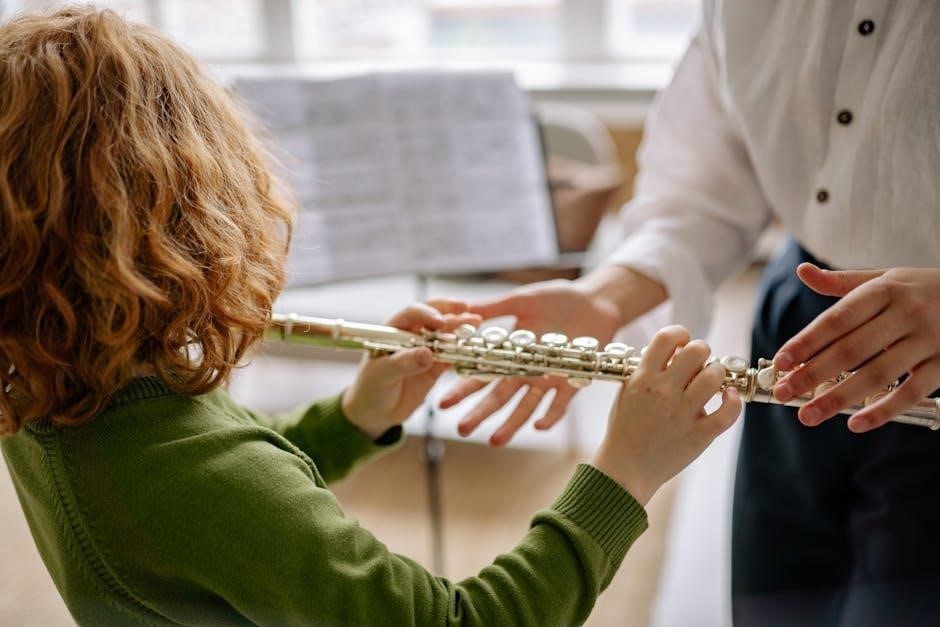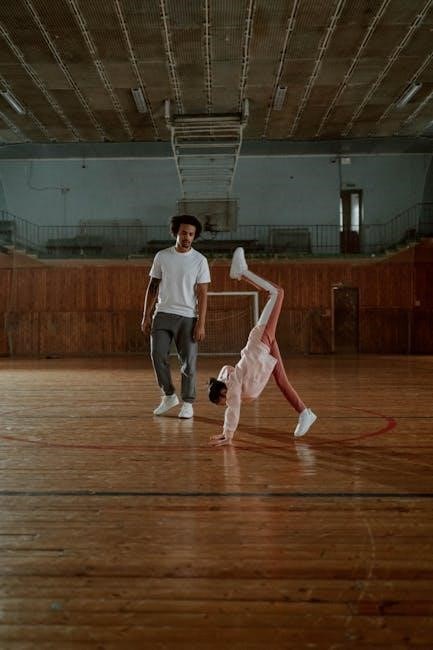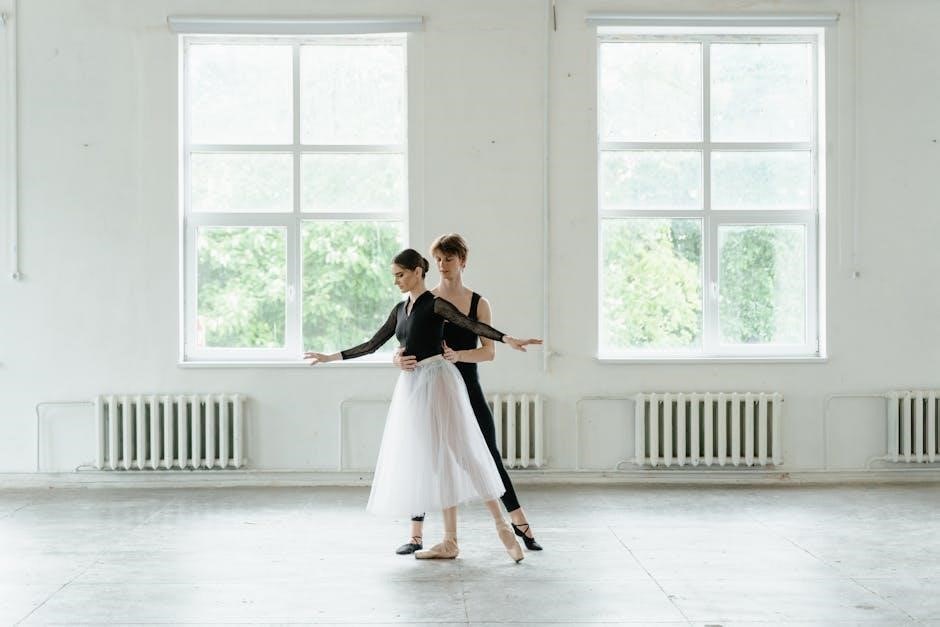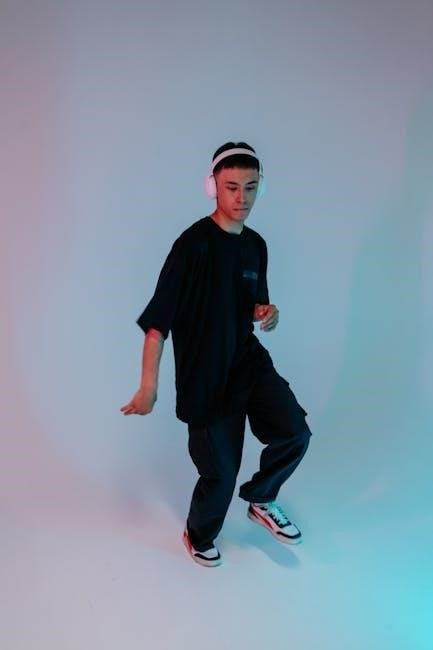Music and movement activities combine rhythm, creativity, and physical expression, fostering gross motor skills, coordination, and self-confidence in young children. These engaging experiences promote social interaction and a lifelong love for music and dance, making them essential in early childhood education.

Benefits of Music and Movement Activities
Music and movement activities enhance gross motor skills, coordination, and creativity. They also improve social, language, and cognitive development, fostering a strong foundation for early childhood growth.
Gross Motor Skills Development
Music and movement activities are essential for enhancing gross motor skills in preschoolers. These activities encourage the use of large muscle groups, improving coordination, balance, and overall physical fitness. Through actions like marching, jumping, and clapping, children develop strength and control over their bodies.
Rhythmic movements, such as swaying or stomping, help refine timing and spatial awareness. These exercises prepare young learners for more complex physical tasks, fostering confidence and readiness for future activities like sports or dance.
Social and Emotional Growth
Music and movement activities play a vital role in fostering social and emotional growth in preschoolers. These experiences encourage emotional expression, empathy, and self-awareness. Through group dances or shared rhythms, children learn to cooperate and take turns, building teamwork and communication skills;
Movement to music also helps children manage emotions, as physical expression provides an outlet for feelings like excitement or calmness. Activities that involve mirroring or following a leader enhance self-confidence and the ability to connect with others. By participating in shared experiences, preschoolers develop a sense of belonging and improved self-esteem, laying a strong foundation for healthy social and emotional development.
Language and Cognitive Enhancement
Music and movement activities significantly contribute to language and cognitive enhancement in preschoolers. Rhythmic patterns and rhyming songs help improve phonological awareness, a key skill for early literacy. Action songs and movement games encourage children to follow directions, enhancing listening and comprehension abilities.
These activities also promote memory development as children recall sequences of movements or lyrics. The repetition of songs and gestures fosters cognitive retention and pattern recognition. Additionally, music and movement stimulate creativity and problem-solving skills, as children explore different ways to express ideas through sound and motion. This holistic approach strengthens the connection between language development and cognitive function, preparing preschoolers for academic success.

Creating Effective Lesson Plans
Plan engaging music and movement sessions tailored to preschoolers’ developmental levels, incorporating varied activities and props to foster participation and learning through structured, adaptable, and fun experiences.
Aligning with Developmental Milestones
Effective lesson plans for music and movement activities should align with preschoolers’ developmental milestones, ensuring activities are age-appropriate and skill-specific. For example, toddlers (2-3 years) focus on basic locomotion like walking and jumping, while preschoolers (4-5 years) refine balance and coordination. Activities should cater to these stages, offering tasks that build on emerging skills. Incorporate simple rhythms for younger children and more complex patterns as they grow. Consider their attention spans and energy levels, balancing active and calm movements. Assessing individual developmental stages allows teachers to tailor activities, fostering a supportive environment where children can explore and grow at their own pace; This alignment ensures that music and movement activities are both engaging and developmentally beneficial.
Incorporating Rhythm and Tempo
Incorporating rhythm and tempo into music and movement activities helps preschoolers develop their sense of timing and coordination; Start with simple rhythmic patterns using instruments or clapping, allowing children to mimic and explore. Varying tempos encourages them to move their bodies differently, such as marching slowly or jumping quickly. Use songs with clear beats to guide movements, making it easier for young learners to follow. For older preschoolers, introduce more complex rhythms, like combining clapping and stomping; This not only enhances their musical awareness but also improves their ability to synchronize movements. Props like tambourines or maracas can add engaging auditory cues, making rhythm and tempo exercises both fun and educational. Adaptive activities ensure all children can participate and learn at their own pace.
Using props like Scarves and Balloons
Scarves and balloons are excellent props for engaging preschoolers in music and movement activities. Scarves can be waved, twirled, or flowed through the air to create a sense of grace and rhythm. Balloons add an element of unpredictability, as their gentle float encourages children to move dynamically to keep them aloft. These props enhance creativity and coordination while fostering a sense of play. Use scarves during slow tempo music for flowing movements or fast rhythms for energetic twirling. Balloons can be incorporated into games like balloon volleyball or balancing challenges. Both props captivate young learners, making activities memorable and enjoyable. They also provide visual feedback, helping children connect their movements with music and tempo. This multisensory approach promotes active participation and imaginative expression.Scarves and balloons are excellent props for engaging preschoolers in music and movement activities. They add color, texture, and fun, encouraging creativity and exploration. Use scarves to create flowing movements or twirl them to match the rhythm. Balloons can be bounced or chased, adding excitement and laughter. These props help develop coordination and imagination while making activities interactive. They also provide a visual element, helping children connect their movements with the music. Incorporate scarves and balloons into themed lessons, such as dancing like butterflies or playing balloon games to upbeat songs. This approach makes learning engaging and memorable, fostering a love for music and movement in young children.

Activity Ideas
Engage preschoolers with creative music and movement activities like Freeze Dance, Animal Moves, and Storytelling through Movement. These activities promote physical expression and creativity, fostering joy and learning.
Freeze Dance and Imitation Games

Freeze Dance is a delightful activity where children dance to upbeat music and freeze in place when it stops. This game enhances self-control and gross motor skills. Imitation Games encourage preschoolers to mimic movements, fostering creativity and social interaction. For example, the teacher can demonstrate animal movements, and children copy them, promoting physical expression and laughter. These activities are simple yet effective, catering to diverse learners and fostering a sense of community. They also provide opportunities for children to practice following directions and exploring their bodies in space. Incorporating props like scarves or ribbons can add an extra layer of fun and engagement, making these games a staple in music and movement lesson plans.

Animal Moves and Action Songs

Animal Moves and Action Songs are engaging activities that combine music with movements inspired by nature. Preschoolers can stomp like elephants, hop like frogs, or flutter like butterflies, enhancing their creativity and coordination. Action songs, such as “The Wheels on the Bus” or “Old MacDonald Had a Farm,” encourage children to act out lyrics, promoting language development and memory. These activities foster an appreciation for rhythm while allowing children to express themselves physically. They also provide opportunities for teamwork and camaraderie as children mimic and follow one another. Simple instruments, like maracas or drums, can further enrich the experience, making learning fun and interactive for young learners.
Storytelling through Movement
Storytelling through Movement engages preschoolers by blending physical expression with narrative. Children act out characters and emotions, enhancing creativity and motor skills. They might mime climbing a mountain or dancing in the rain to music that matches the mood. This activity sparks imagination and deepens their connection to the story. Teachers can add simple instruments or sound effects for a more immersive experience. It entertains while educating, fostering emotional intelligence and teamwork as children collaborate to tell a story. Such activities are versatile and can be adapted to different themes and age groups.
Teacher Tips and Strategies
Encourage active participation by modeling movements and providing positive feedback. Keep activities short and engaging to maintain focus. Use visual cues and transitions smoothly between exercises.
Managing Transitions Smoothly
Transitions in music and movement activities can be challenging for young children. To manage them smoothly, use visual timers to signal upcoming changes. Play specific songs or beats to cue transitions, helping children anticipate what’s next; Incorporate simple, repetitive phrases like, “Let’s clean up the scarves and find our next spot;” Use props like scarves or ribbons to guide movements during transitions, keeping children engaged. End one activity with a calming movement, such as stretching or deep breathing, to prepare for the next. Keep instructions clear and brief, ensuring children understand expectations. By planning intentional transitions, you maintain focus and create a seamless flow between activities, fostering a positive and structured learning environment.
Encouraging Creativity
Encouraging creativity in preschoolers during music and movement activities is essential for their development. Allow children to explore and express themselves freely by incorporating open-ended activities. For example, let them create their own movements to a rhythm or invent a dance inspired by a favorite animal. Provide opportunities for improvisation, such as letting them choose instruments or make up lyrics to a simple melody. Use props like scarves or ribbons to inspire imaginative gestures. Praise their unique ideas and efforts, fostering confidence and self-expression. By giving children the freedom to explore and create, you help them develop a love for artistic expression and build foundational creative thinking skills that benefit all areas of their growth.

Using Instruments Effectively
Using instruments effectively in music and movement activities for preschoolers enhances engagement and learning. Start with simple, child-friendly instruments like tambourines, maracas, or xylophones. Introduce them gradually, demonstrating how to hold and play each one. Encourage children to experiment with rhythms and sounds, linking movements to the music they create. For example, shake maracas while marching or tap tambourines during a clap-along song. Rotate instruments periodically to ensure everyone gets a turn. This fosters sharing and cooperation while developing fine motor skills and musical awareness. Keep the focus on fun and exploration, allowing children to express themselves through sound and motion. This approach helps build confidence and a lifelong appreciation for music and movement.
Assessment and Adaptation
Assess preschoolers’ participation and progress in music and movement activities. Observe their engagement, skill development, and willingness to explore. Adapt activities to meet diverse learning needs, ensuring inclusivity and fun for all children while fostering creativity and growth.
Observing Participation and Progress
Observing preschoolers during music and movement activities is crucial for understanding their engagement and development. Pay attention to their enthusiasm, willingness to follow directions, and ability to imitate actions. Note improvements in coordination, rhythm, and creativity over time. Use simple checklists or anecdotal records to document progress, such as increased confidence or better motor control. Observing how children interact with peers and instruments provides insights into social and emotional growth. Regularly monitoring their participation helps identify areas where support or challenges are needed. This process ensures activities are tailored to their evolving skills, fostering a nurturing and inclusive environment for all learners.
Adapting for Diverse Learners
Adapting music and movement activities ensures inclusivity for all preschoolers, regardless of their abilities or needs. For children with physical challenges, modify movements to accommodate mobility limitations, such as seated actions or using assistive devices. For sensory-sensitive learners, introduce gentle music and soft props to minimize overwhelming stimuli. For those with developmental delays, break down complex movements into simpler steps and provide additional support. Visual cues, such as pictures or gestures, can aid language learners. Encourage peer assistance and model inclusivity to foster a supportive environment. By tailoring activities to meet individual needs, every child can engage meaningfully, building confidence and a love for music and movement. This approach ensures all learners feel valued and included.
Free Resources and PDFs
Discover a variety of free downloadable PDFs offering themed music and movement activities, including printable sheet music and engaging lesson plans for preschoolers.
Printable Sheet Music
Printable sheet music is a valuable resource for preschool music and movement activities. Many websites offer free, downloadable sheets tailored for young children, featuring simple melodies and rhythms. These sheets often include child-friendly compositions that encourage movement, such as clapping, marching, or dancing. Teachers can use these resources to create engaging lesson plans that align with developmental milestones. Some sheets include visual cues, like colors or symbols, to help preschoolers follow along. Instruments like xylophones or maracas can be incorporated to enhance the experience. Printable sheet music is also a great way to introduce children to musical notation in a fun, accessible way. This resource supports creativity and motor skill development while fostering a love for music early on.

Themed Activities

Themed activities are a fantastic way to make music and movement engaging for preschoolers. Themes like “Animal Adventure,” “Outer Space Exploration,” or “Holiday Celebrations” can inspire creative movements and sounds. For example, children can pretend to be animals, hopping like frogs or roaring like lions, while music plays. Holiday-themed activities might include dancing with ribbons or marching like soldiers in a parade. These themes help children connect movement with imagination, fostering creativity and enthusiasm. Teachers can customize themes to align with classroom curriculum or seasonal events, making learning fun and relevant. Themed activities also encourage teamwork and social interaction, as children work together to create a cohesive performance or routine. This approach keeps young learners excited and invested in music and movement experiences.
Music and movement activities are a powerful tool for fostering development in preschoolers, offering a fun and engaging way to promote physical, social, and cognitive growth. By incorporating rhythm, creativity, and play, educators can create meaningful experiences that resonate with young learners. The strategies and resources outlined in this guide provide a foundation for designing effective lesson plans tailored to preschoolers’ needs. Remember, the goal is to inspire a lifelong love of learning through movement and music. With consistency, creativity, and patience, teachers can help children thrive in a nurturing and dynamic environment. Embrace the joy of music and movement to unlock the full potential of your students and watch them grow into confident, expressive individuals.
